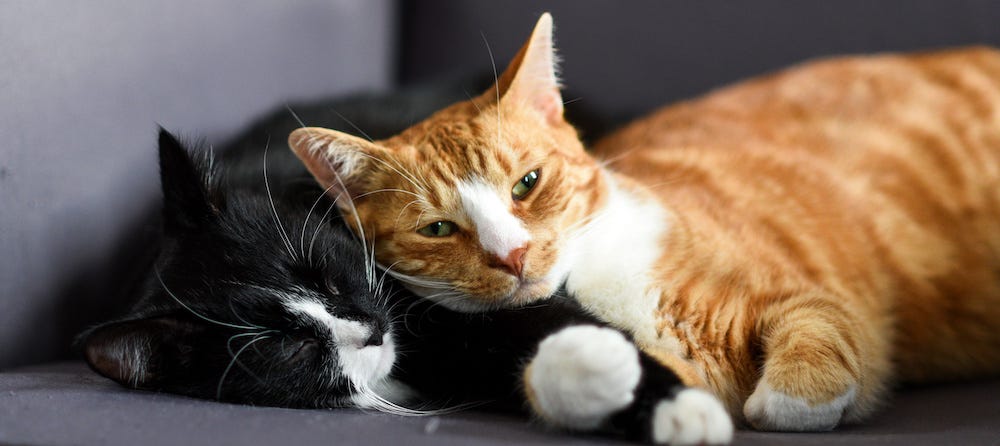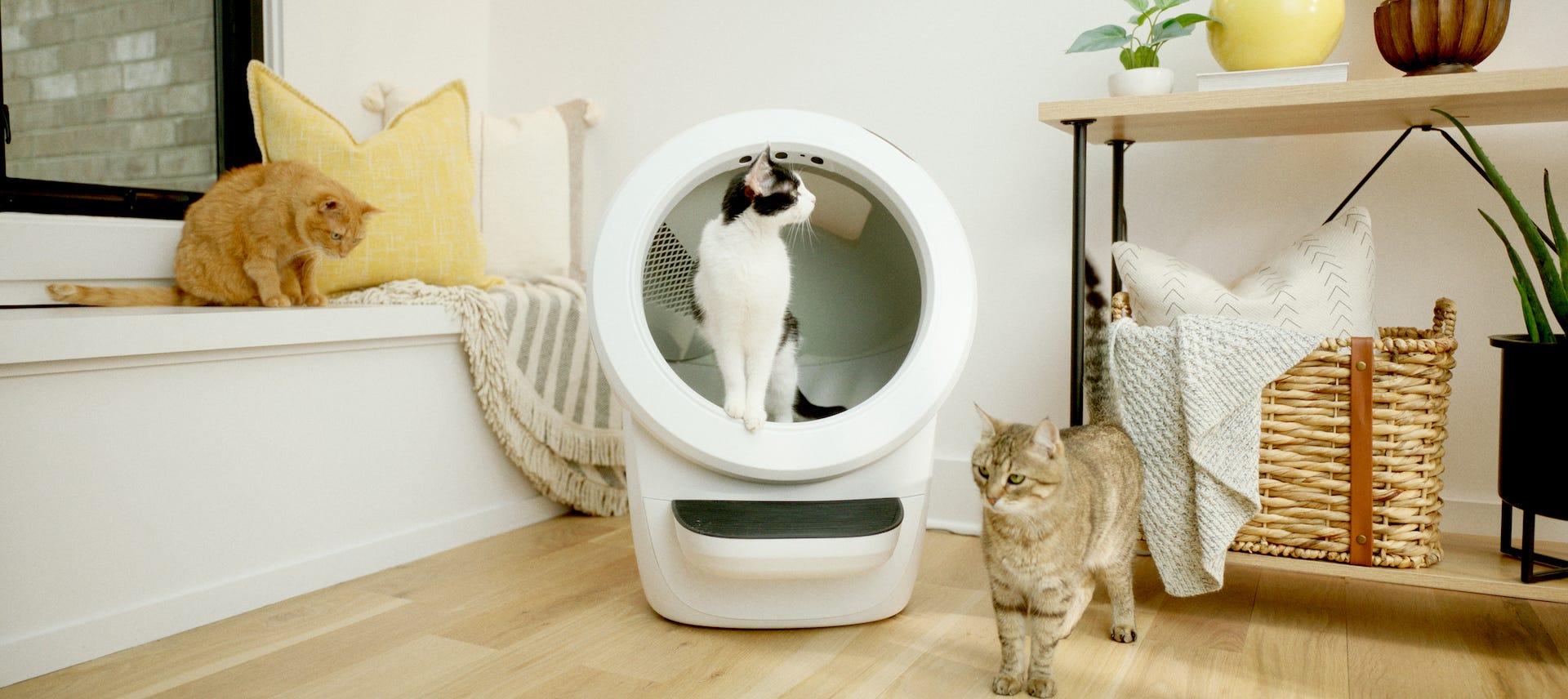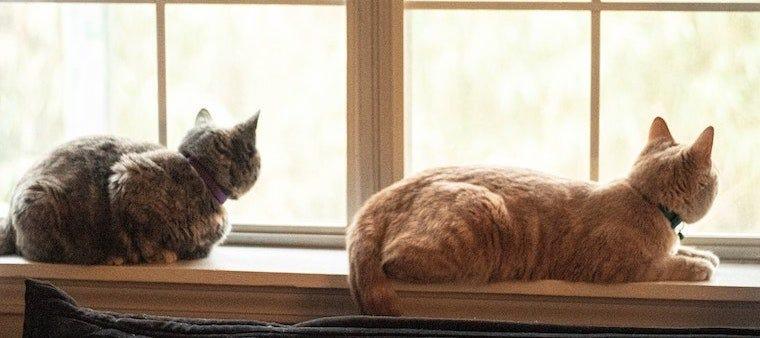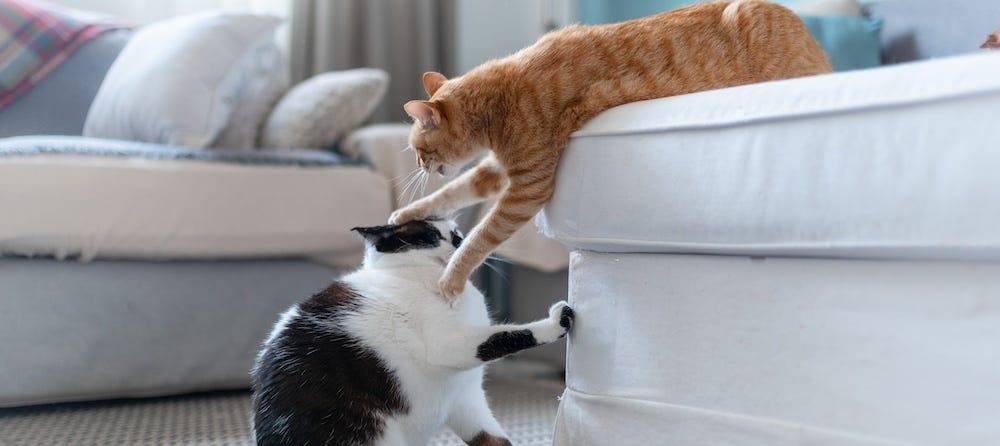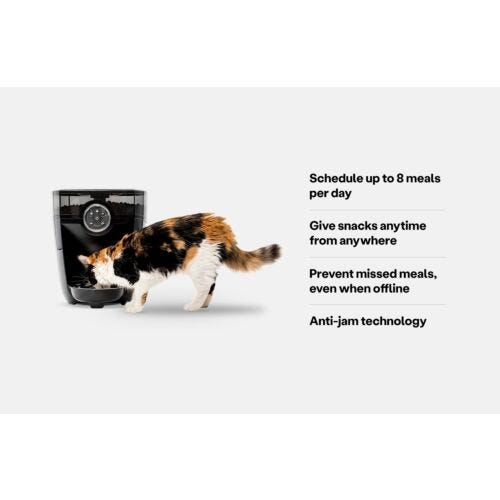The benefits of having multiple cats are obvious: Cats have a companion to bond with when their humans aren’t around, and you have more furry family members to cuddle and play with!
But with multiple cats comes unique challenges. Our guide to managing a multi-cat household will cover topics such as how to introduce cats, mealtime conflicts, how many litter boxes to provide, health considerations, and common mistakes to avoid.

Cat socialization
Do cats need another cat?
Some cats are perfectly content to be the only feline in the home, while others thrive with a furry companion. Personality, breed, and home environment are important factors for determining if your cat would benefit from a feline friend.
If you (or other family members) are normally home and can provide lots of stimulation and cuddles, even a needy cat can be content without a kitty playmate. Highly active cat breeds are more likely to benefit from having a cat sibling.
Signs your cat is lonely
Despite their reputation as aloof creatures, cats crave companionship. If they are frequently left on their own for hours or even days at a time, they can experience separation anxiety, loneliness, or depression.
Signs that your cat is lonely may include behaviors such as excessive vocalization, overgrooming, destructiveness, aggression, and litter box issues.
How many cats is too many cats?
We all know one: That crazy cat person (normally a term of endearment) who seems to accumulate too many felines. They may adopt a new cat every couple of years, have a series of foster fails, or “collect” strays out of the goodness of their hearts. Whatever it is, there comes a point when you have to ask: How many cats is too many cats?
Veterinarians recommend no more than four to five cats in a household, with a hard cutoff of six cats.
Why? Veterinary behaviorists and veterinarians often see increased medical and behavioral problems when there are more than five cats in a household.
Introducing new cats
Friendliest cat breeds
If you’ve decided to add another cat to your family, how do you find one who is most likely to get along with everyone in the home—other pets included?
At your local animal shelter you’ll likely encounter mixed or “moggy” cats, sometimes called Domestic Shorthairs and Domestic Longhairs. These cats often embody the best of many worlds: friendly temperaments, adorable looks, and a lower risk for inherited diseases.
Other friendly cat breeds include:
- Maine Coon
- Bengal
- Siamese
- Ragdoll
- Sphynx
- Siberian
- Oriental Shorthair
- American Shorthair
- Bombay
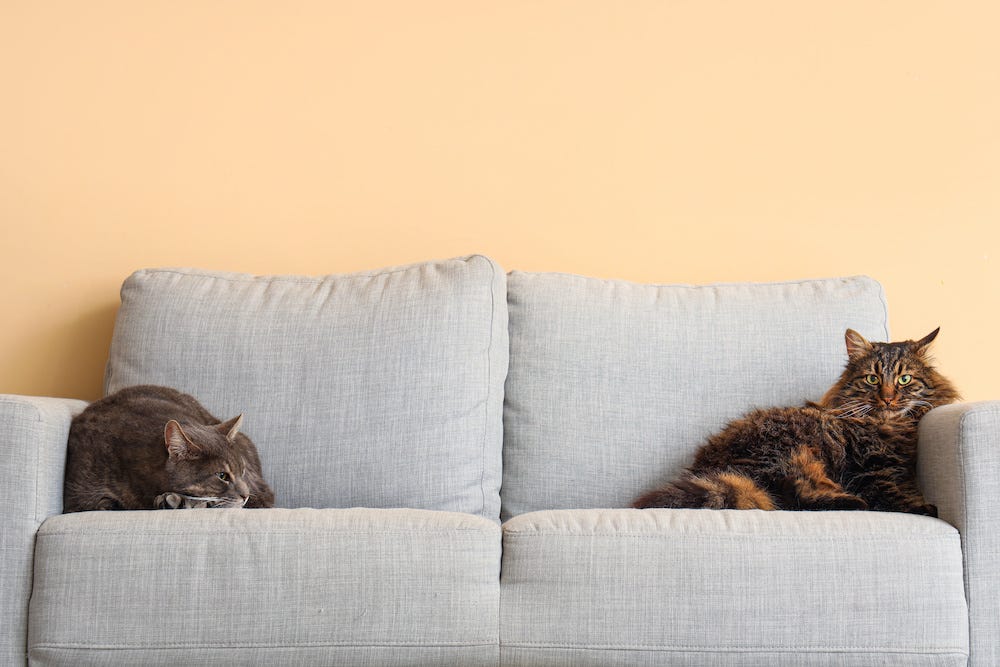
How to get two cats to get along
Veterinarians stress that it’s very important that you introduce cats to each other correctly—or you may have a lifelong problem with them not getting along.
- Go slow with introductions: We’re not talking a few days here but a few weeks! This allows everyone to relax and have time to adjust to the new situation.
- Recognize cat body language: Watch for telltale signs that your cat is stressed or uncomfortable. These include flattened ears, dilated pupils, holding the tail close to the body, growling, tail flicking or swishing, running away, freezing, hissing, swatting, and more.
- Set up two home bases: Ideally these are separate rooms with closed doors for each cat, where the other cat can’t go. Each of these should include resting, feeding, water, and litter stations.
- Swap scents: Once you’ve set up your cats in their own space, consider introducing a towel with the other cat’s scent on it. After a day, once they’ve gotten used to it, consider rotating rooms/base stations for 1-2 hours a day.
- Try Feliway Multicat: This is a diffuser you can use throughout the house that mimics natural pheromones and has been shown to minimize stress during new cat introductions.
- Let the cats meet: Once your cats seem comfortable, allow them to meet through a cracked door or sniff under the bottom of the door. Reward good behavior immediately with treats! As the days progress and everything is going well, you can gradually open the door a few more inches. Keep in mind that this can take several weeks, but it’s always better to go slowly than to introduce cats too quickly and create lifelong fighting.
If your cats still aren’t getting along, consult with a board-certified veterinary behaviorist as soon as possible to help identify and fix the problem.
Providing adequate resources
How much space do cats need?
There isn’t a strict rule for how much space cats need, as it varies greatly from cat to cat. Some experts suggest a minimum of 18 square feet, keeping in mind that cats should have access to vertical space (cat trees, wall shelves, window perches, etc.) as well as floor space.
Temperament and breed play a role in determining how much space to give your cats. Young or energetic cats may require more space to run and roam, while older or lazy cats may be more content with a smaller amount of space.
Can a cat live in one room?
Yes, a cat can live in one room. Some cats, particularly those that experienced trauma earlier in life, may even prefer it. However, most cats thrive when they have multiple rooms to explore and a variety of stimulating environments.
Providing safe zones and hiding spots
Veterinary studies have found that the more cats there are in one household, the higher the prevalence of behavioral problems. That’s why it’s important to provide a separate safe place for resources for each cat that you have. (This doesn’t necessarily mean a separate ROOM for each cat—even a corner of the room with a cat condo or wall shelves will suffice.)
This way, each cat can go somewhere for some alone time. Make sure there’s plenty of toys, a litter box, food, a clean water source, and a sleeping area. This will help prevent fighting over resources.
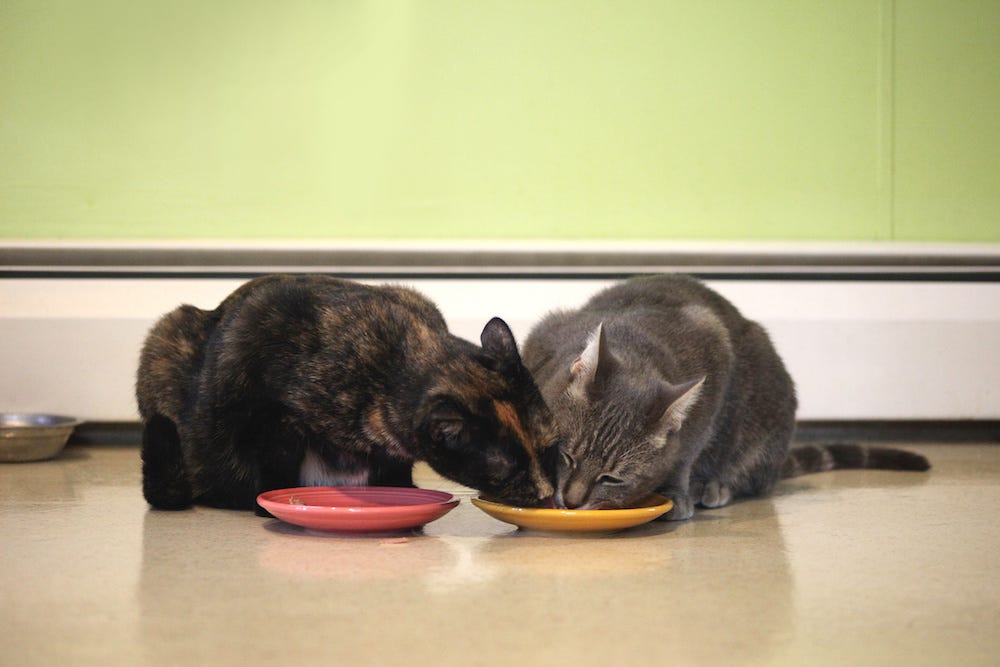
Food and water stations
It’s important to provide multiple food and water stations in your multi-cat household.
How to feed multiple cats
Territorial or assertive cats may guard their food bowl and prevent access to other cats. That is why you should set out food and water bowls in multiple areas of the home.
Meal-feeding with canned or wet food two to three times a day may be more useful in a house with multiple cats—as opposed to free-feeding, or leaving out a large amount of dry food for everyone to share. Learn more about what and how much to feed your cats.
Make sure water bowls or pet fountains are always freely available in several areas of the home. Some cats prefer moving water versus stagnant water in a water bowl, but all cats can appreciate multiple water sources.
Managing mealtime conflicts
If mealtimes are especially stressful, set up feeding stations in separate rooms for each of your cats (doors closed, if needed), and feed them all at the same time. That way you are there to supervise if one cat tries to monopolize the food dish.
This approach is also useful if one of your cats has a prescription diet and must be fed separately from the others.
How to keep cats from eating each other's food
Getting just one of your cats to lose weight might feel like an impossible task, especially when one keeps eating the other’s food. So how can you help a cat lose weight with multiple cats? Rest assured, there are options!
Try environmental modifications like the following:
- Feed your slimmer cats on a high surface, such as a counter or shelf, that your overweight cat is unable to jump to.
- If the slimmer cats can jump a baby gate while the overweight cat cannot, use this barrier to block off the room(s) with the food part of the time.
- Use a hook and eye closure to open the door to the room(s) only enough for the slim cats to enter, not the overweight cat.
Ready to bring pet technology into the equation? Try a cat flap or pet feeder that is activated by your cat’s microchip or special collar.
Managing litter boxes in a multi-cat home
Multiple cats = multiple litter boxes = multiple problems. Or does it? Get tips below.
Can two cats share a litter box?
While cats can share a single traditional litter box, it is not recommended in a multi-cat household. Doing so can lead to territorial disputes and reluctance to use a shared box. The exception is if you provide an automatic litter box where your cats have a clean place to go every time.
How many litter boxes for how many cats
The rule for how many traditional litter boxes to have is n+1 litter boxes per cat, meaning you should have as many litter boxes as you have cats, plus one. So, if you have two cats you should have three litter boxes. Three cats, four litter boxes—and so on.
Again, the exception is if you have a self-cleaning litter box. For example, one Litter-Robot works for up to four cats because it provides a clean bed of litter after every use.
The best litter box for multiple cats
When choosing the best litter box for multiple cats, remember that cleanliness and comfort are crucial. You’ll want to ensure that all regular litter boxes are scooped daily, and perform a complete litter change as needed.
Your choice boils down to having either multiple traditional litter boxes or an automatic litter box. For the traditional route, you can’t beat large, stainless steel litter boxes. These are easier to clean, more durable, and less likely to track litter than small plastic litter boxes.
If your cats are territorial, you may want to try a self-cleaning litter box. These ensure that your cats always have a fresh bed of litter, and you won’t have to scoop the litter box anymore. Win-win!
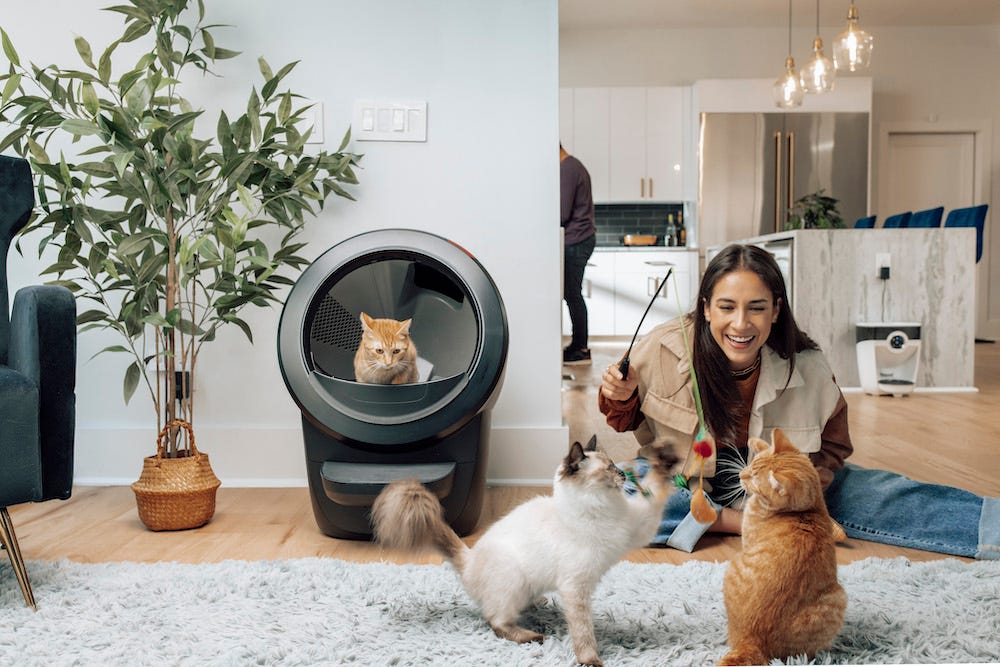
The best self-cleaning litter box for multiple cats
With an automatic litter box, having multiple cats no longer equates to needing multiple litter boxes. Not only is a consistently clean bed of litter good for your cats’ health, it helps reduce territorial disputes over the litter box. Look for these features in the best self-cleaning litter box for multiple cats:
- Rapid, reliable cleaning
- Wide opening and spacious litter bed
- Large waste drawer
- Odor control
- Multi-cat recognition
Litter-Robot 4 is smart, automatic, and suited for up to four cats. You can even track each of your cats’ weights and litter box usage using the Whisker app, helping you keep tabs on their overall health.
Best cat litter for multiple cats
Multiple cats using the same litter boxes can create strong odors and bigger messes. When you’re looking for the best cat litter for multiple cats, consider factors such as odor control, dust level, clumping ability, and material type.
In general, you should avoid non-clumping litter in multi-cat homes; it requires more cleaning and leads to stronger odors. Instead, look for an all-natural clumping litter like GreatLitter, which is made of sun-dried clay to reduce litter dust and tracking caused by multiple cats. It also reduces odors thanks to fast clumping action.
Health and veterinary care
Importance of spaying and neutering
Spaying and neutering cats is essential, especially when you have multiple in your home. Besides reducing cat overpopulation (a home filled with kittens sounds delightful, in theory, but would be chaos in reality!), here are just a few of the reasons to spay and neuter:
- Reduces the risk of developing certain types of deadly cancers and malignant tumors
- Reduces the risk of contracting fatal diseases via cat fights
- Reduces the likelihood of dangerous outdoor roaming
- Helps eliminate unwanted indoor behaviors like spraying, howling, going into heat, fighting, defending their territory, wanting to escape, and inappropriate urination
The general recommendation on when to spay and neuter cats is to “Fix Felines by Five”—so, by five months old, before they go into their first heat cycle.
Managing illness in a multi-cat household
Learn how to manage the spread of illness between multiple cats (and humans).
Illnesses that can spread between cats
Some illnesses are highly contagious among cats. Pet parents are responsible for keeping all pets in the house as healthy as possible, which may mean quarantining one cat from the others during a bout of illness.
Newly adopted cats should be kept indoors only and away from other cats in the house for at least 7 days.
Some common contagious infections or diseases among cats include:
- Upper respiratory infections (URIs), also known as the “feline common cold”
- Conjunctivitis
- Gastrointestinal worms
- Ringworm
- Feline immunodeficiency virus (FIV)
- Feline leukemia (FeLV)
For certain serious diseases, strict precautions should be taken to reduce the likelihood of spread. You’ll want to ensure all your cats are fully vaccinated and get along well (as many diseases are passed through bite wounds). Ask your veterinarian about eliminating shared food and water bowls. As a last resort, cats may need to be permanently separated.
Zoonotic diseases
Zoonotic diseases or infections are those that can be transmitted between animals and humans. These include, but are not limited to:
- Rabies
- Toxoplasmosis
- Salmonella
- Campylobacter
- Giardia
- Ringworm
- Gastrointestinal worms.
Although it is very unlikely you will get sick from your cat, here are some tips to prevent unwanted spread:
- Keep your cat indoors and up-to-date on vaccines, including their rabies shot.
- Wash your hands after cleaning the litter box or try a self-cleaning litter box. (Pregnant or immunocompromised people should not handle cat feces.)
- Wear gloves while gardening.
- Feed your cat cooked, commercially processed food.
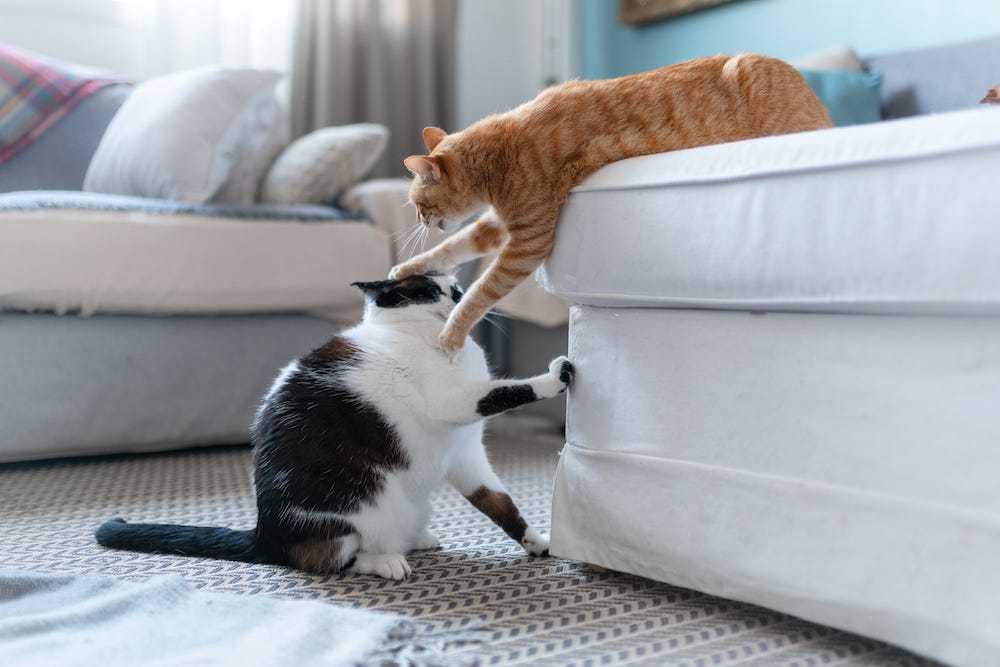
Common mistakes to avoid with multiple cats
Ignoring signs of stress or conflict
It’s not uncommon for cats to not cohabitate well. Find out how to determine if your cats are getting along, and what to do if they aren’t.
How to tell if cats are playing or fighting
Mock fighting or play aggression is normal behavior for cats. But it isn’t always easy to tell the difference between these and real aggression. We must turn to body language to tell whether cats are playing or fighting.
Typically, play fighting is silent. Hissing can be harmless in some cases, but can also be a warning sign of pain, annoyance, or stress, or an indication the play is too rough.
On the other hand, growling is often a sign of fighting behavior. Additionally, cats’ ears will be pinned back and their fur or tails will be puffed during aggressive interactions.
Territorial behavior
If you notice one or more of your cats peeing everywhere in the house, territorial issues may be the cause. When a cat sprays, they release a small amount of urine mixed with scent chemicals to mark their territory. They may do this because they feel threatened or stressed by other animals in the house.
Ways to reduce territorial behavior like spraying are to spay and neuter your cats, clean the litter box frequently (and provide enough litter boxes), and allow cats space from one another. Use a pet-safe, enzyme-based cleaner to eliminate odors caused by spraying.
How to calm an aggressive cat
If your cat is behaving aggressively, it’s best to rule out underlying medical concerns with your vet. In a multi-cat household, your cat might behave this way due to territorial issues, incompatible temperaments, a lack of socialization, or the consequence of feeling overcrowded.
Try these tips for how to calm an aggressive cat:
- Provide a safe, quiet space away from other pets and people. Examples include a cat condo, high shelves, or a special room for them to chill out.
- Make sure your cats have been introduced properly. If you notice aggression between two particular cats, separate them and slowly reintroduce them using positive reinforcement and barriers as needed.
- Try feline pheromone products such as Feliway. These are sold as wall plug-ins, sprays, wipes, or as part of a cat collar.
- Talk to your vet about supplements and medications. They may recommend holistic veterinary supplements or prescription medications like SSRIs. (Never give your medications to your cat!)
Inadequate resources allocations
Make sure your cats aren’t competing for resources. And the resource that cat parents most commonly overlook (or perhaps wish to ignore)? The litter box.
Having too few litter boxes
When there aren't enough litter boxes, cats may compete to access the available ones. This competition can lead to stress, anxiety, and territorial disputes among the cats.
Cats may develop inconsistent litter box habits if there's competition or if they feel uncomfortable sharing a box with other cats. Some cats may choose alternative locations for elimination, leading to litter box avoidance or inappropriate urination and defecation.
When the litter box is too dirty
Cats generally don’t want to use a dirty litter box. If they smell another cat’s waste recently left in the litter box, they may decide to go to the bathroom elsewhere. Or worse, they may choose to only urinate once a day instead of 2-3x/day. When this happens, their urine becomes very concentrated, and with it, all the toxins and waste that your cat’s body is trying to remove become more concentrated. This can potentially result in signs of a urinary tract infection, feline idiopathic cystitis, or, worse, a life-threatening urinary obstruction.
Regular scooping and cleaning are essential in a multi-cat household to prevent odors and maintain a hygienic environment. Aim to scoop the litter boxes at least once a day in a single cat household and even more, if needed, in a multi-cat household.
Or try a self-cleaning litter box that provides all the cats in your home with a fresh place to go, every time!
